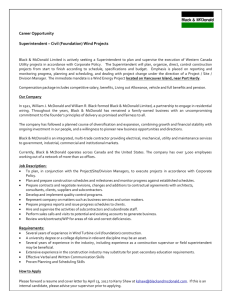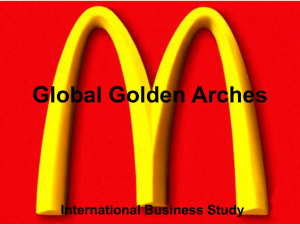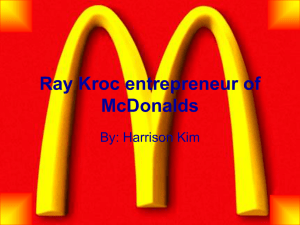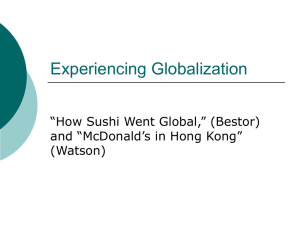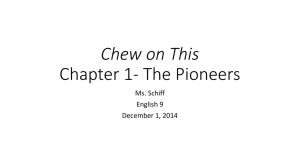The Greening of McDonalds
advertisement
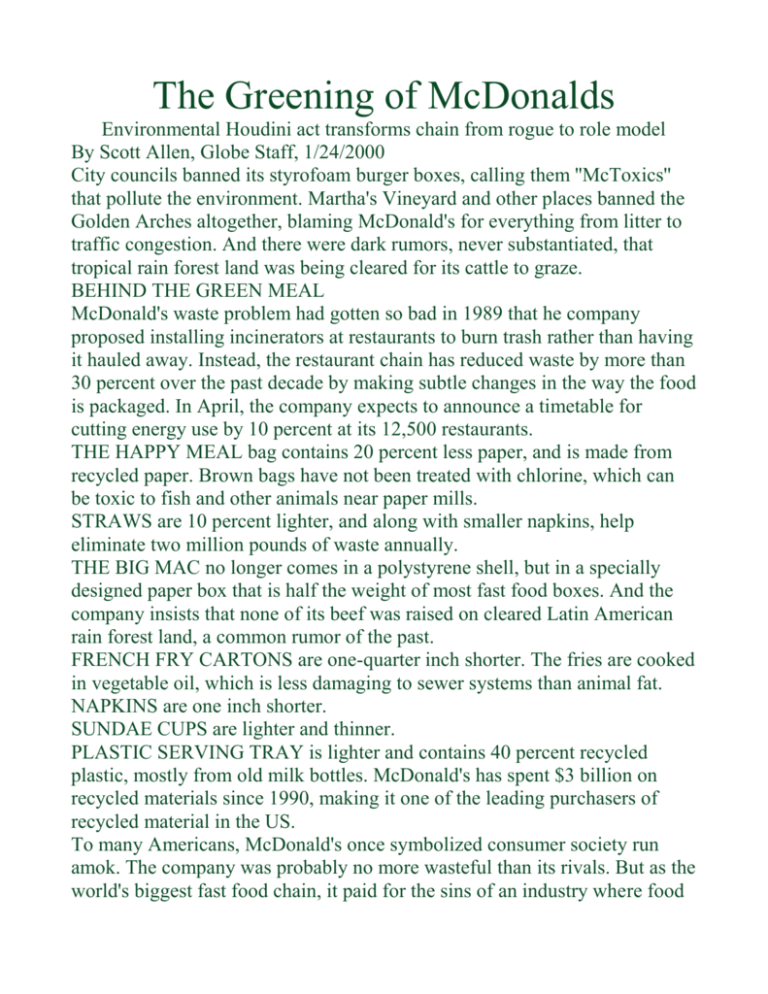
The Greening of McDonalds Environmental Houdini act transforms chain from rogue to role model By Scott Allen, Globe Staff, 1/24/2000 City councils banned its styrofoam burger boxes, calling them ''McToxics'' that pollute the environment. Martha's Vineyard and other places banned the Golden Arches altogether, blaming McDonald's for everything from litter to traffic congestion. And there were dark rumors, never substantiated, that tropical rain forest land was being cleared for its cattle to graze. BEHIND THE GREEN MEAL McDonald's waste problem had gotten so bad in 1989 that he company proposed installing incinerators at restaurants to burn trash rather than having it hauled away. Instead, the restaurant chain has reduced waste by more than 30 percent over the past decade by making subtle changes in the way the food is packaged. In April, the company expects to announce a timetable for cutting energy use by 10 percent at its 12,500 restaurants. THE HAPPY MEAL bag contains 20 percent less paper, and is made from recycled paper. Brown bags have not been treated with chlorine, which can be toxic to fish and other animals near paper mills. STRAWS are 10 percent lighter, and along with smaller napkins, help eliminate two million pounds of waste annually. THE BIG MAC no longer comes in a polystyrene shell, but in a specially designed paper box that is half the weight of most fast food boxes. And the company insists that none of its beef was raised on cleared Latin American rain forest land, a common rumor of the past. FRENCH FRY CARTONS are one-quarter inch shorter. The fries are cooked in vegetable oil, which is less damaging to sewer systems than animal fat. NAPKINS are one inch shorter. SUNDAE CUPS are lighter and thinner. PLASTIC SERVING TRAY is lighter and contains 40 percent recycled plastic, mostly from old milk bottles. McDonald's has spent $3 billion on recycled materials since 1990, making it one of the leading purchasers of recycled material in the US. To many Americans, McDonald's once symbolized consumer society run amok. The company was probably no more wasteful than its rivals. But as the world's biggest fast food chain, it paid for the sins of an industry where food was slapped in elaborate wrappers that were thrown away by hungry customers minutes later. Yet in one of the great Houdini acts of modern conservation, McDonald's has gone from villain to role model in the past 10 years. Turning to professional environmentalists for advice, McDonald's has reduced its waste by more than 30 percent since 1990, become one of the country's leading buyers of recycled materials, and cut its energy use to boot. ''This company has been a leader on the environment, not only for the industry, but also for corporate America as a whole,'' said Fred Krupp, director of Environmental Defense, a nonprofit group formerly known as the Environmental Defense Fund, which helped McDonald's reduce waste. ''They've made a long series of commitments and they've hit every target.'' Now, environmental analysts are asking whether fast food could be considered ''environmentally sound'' after all, a notion that is anathema to many activists. Even if McDonald's and other chains produced no waste at all, they would still face criticism about their menus' heavy reliance on beef, one of the most environmentally damaging foods to produce due to cattles' food needs and waste. McDonald's ''may have gotten rid of Styrofoam cups, but they haven't gotten rid of Styrofoam buildings,'' joked Ronald Lee Fleming of Cambridge, Mass.'s Townscape Institute, which works with communities to pressure fast food chains to build restaurants that blend in with the architecture of surrounding buildings. But Environmental Defense's ongoing work with McDonald's reflects the reality that Americans flock to fast food whether or not their dinner is healthy for the planet (or their arteries). Burger King sales continued to rise even when activists called for a boycott of the restaurant in 1988 over the company's alleged purchase of beef raised on cleared Costa Rican rain forest land. Indeed, fast food industry sales have risen from one quarter to one half of all restaurant sales since 1970. Today, Americans spend one-seventh of their food budget on Big Macs and other fast food, making it the second most important source of nutrition next to home cooking. And, with 12,500 McDonald's restaurants in the United States, most Americans live within three miles of one. Yet, ironically, the sheer omnipresence of fast food could actually prove to be an environmental advantage. When McDonald's insisted on cardboard boxes made of recycled paper, the order was so large that box companies adopted McDonald's standard as the one for all of its customers, both in and outside the restaurant business. Moreover, the efficiency of fast food restaurants make them less wasteful than many conventional restaurants, according to Warren Leon, author of the book ''The Consumer's Guide to Effective Environmental Choices.'' If McDonald's succeeds in a plan it has to turn food waste into fertilizer, eating at McDonald's could generate less waste than eating at many homes. So Jackie Roberts, one of the Environmental Defense scientists who has worked with McDonald's since 1990, continues to strive for greener fast food rather than cursing its shortcomings. Nobody's perfect, she said, and the point is to try to improve. ''I don't feel like there is anything in my life that I can do that is guilt-free. Even if I go for a hike ... I drive a long way to get there,'' said Roberts, who helps businesses reduce waste at Environmental Defense's Alliance for Environmental Innovation in Boston. The greening of McDonald's has been perceptible only to the most observant customers. The change most people noticed was the 1990 disappearance of the controversial polystyrene ''clamshell'' box that once held the Big Mac since replaced by a special lightweight paper - but there has been a steady parade of changes in the dining area since then as well. For example: Napkins are 1 inch shorter, cutting down on needed paper by 21 percent, and they are now made from recycled newspapers, giving them a slightly offwhite color. Most food is wrapped in paper now, too, instead of plastic or cardboard, cutting down on materials needed to make wrappers by 80 percent. The company has cut back on plastic use as well, making the straws shorter, the dining trays lighter, and the garbage bags thinner. Much of the playground equipment is now made of recycled plastic as well, part of a corporation-wide $3 billion purchase of recycled materials since 1990. McDonald's periodically uses the liners of its food trays to tell customers about its environmental progress, such as its commitment to protecting tropical rain forests through financial support of the group Conservation International. In general, however, McDonald's has avoided asking for any sacrifices from consumers, largely because it hasn't worked in the past. When the company introduced bins for recyclable materials, they found the paper was too contaminated with grease to recycle, or a bagful of otherwise perfectly recyclable polystyrene boxes had Coke spilled on it. ''It was a struggle to recycle in our stores,'' admitted Robert Langert, McDonald's director of environmental affairs. ''Even if you've got 99 percent of the people doing a good job, you've still got a problem with that one percent.'' Fortunately, scientists from Environmental Defense discovered early on that the real opportunities were behind the food counter - in reducing the cardboard boxes, egg shells, coffee grounds, and other materials that, collectively, account for 80 percent of McDonald's waste. Working for a day in a Falls Church, Virginia, McDonald's, Roberts of Environmental Defense realized that the path to improvement lay in making waste reduction part of the highly regimented system that allows McDonald's to feed 40 million people a day. ''To me, the choreography was just amazing,'' she recalled. ''And I was thinking, `anything we do has to fit into this system.' '' As it turned out, waste reduction and recycling fit beautifully into the McDonald's system, in part because it saved money. Recycling cardboard immediately cut restaurants' waste disposal bills by 30 percent, while the company saves $5 million a year by requiring lighter and smaller packaging and supplies. Beyond money, the unusual partnership between McDonald's and Environmental Defense worked because the two sides trusted each other. McDonald's officials knew they needed outside help to restore their battered image, while Environmental Defense braved criticism from fellow environmentalists for a chance to work inside a corporate nemesis. Today, other companies are following McDonald's lead on environmental issues. Burger King, the number two hamburger chain, copied McDonald's switch to paper hamburger wrappers in 1991, while Taco Bell, Pizza Hut, and Kentucky Fried Chicken recently shrunk their napkins as McDonald's did earlier. However, McDonald's has done far less on more complex environmental issues. Their burger-dominated menu, for instance, would require a change in their business strategy and the cooperation of millions of customers. ''A lot of the bigger, more harmful impacts associated with food aren't from the packaging of food, but from the production of food itself,'' said John C. Ryan, author of the book ''Stuff: The Secret Life of Everyday Things,'' which examines the environmental impact of consumer goods. Ryan estimates that a quarter-pound hamburger requires 616 gallons of water to produce, from the water for corn and other crops fed to the cattle, to the water pollution caused by the animals' feces. Analyst Leon calculates that the production of beef does 15 times more damage per serving than poultry because cattle grazing tends to denude and erode the land. ''Almost any kind of farm-raised meat is an inefficient use of resources, but red meat is most wasteful of all,'' said Ryan. ''Have a veggie burrito next time.'' McDonald's officials say that if customers wanted veggie burritos, they would gladly serve them, but most people don't want them. McDonald's already offers chicken, fish, salads, muffins, and other non-beef alternatives, but ''the hamburger continues to be the flagship sandwich,'' said McDonald's spokesman Walt Riker. ''We have to be responsive to our customers.'' McDonald's also faces criticism for its role in ''sprawl,'' those unattractive commercial strips on the outskirts of towns that critics say drain business from existing downtowns, encourage people to drive more, and eat up open space. In part because of McDonald's reputation for shrewd real estate choices, its restaurants can trigger new sprawl as other retailers try to locate near the new McDonald's. ''There's kind of a huge blind spot with many of the largest corporations,'' said Constance Beaumont of the National Trust for Historic Preservation in Washington D.C. ''They don't really look at the big picture, for example, the `auto-centricity' of their operations ... in the middle of nowhere accessible only by car.'' Currently, McDonald's doesn't have an anti-sprawl policy, but it does respond to community demands, such as building a restaurant in an existing Victorian house in downtown Freeport, Maine, and building an earth-tone and teal restaurant to blend in with the mountains in Sedona, Arizona. ''We can't do anything without official approval,'' said spokesman Riker, pointing out that it's up to communities to decide what the ground rules are for commercial development. More generally, some public officials argue that McDonald's actually helps preserve urban areas by providing entry-level jobs that keep some people from moving away. Chicago Mayor Richard Daley even held a ''Golden Arches'' day last year, declaring that the 115 McDonald's in the city have ''been a great partner in revitalizing Chicago's neighborhoods.'' Overall, environmental analysts are humbler today about passing judgment on McDonald's than activists were when the company was under attack a decade ago. Looking back, they believe that some issues, such as the industry's links to cattle raised on cleared rain forest, were overblown, and that assessing the true environmental impact of any industry, especially one as complex as fast food, is nearly impossible. As a result, neither authors Leon and Ryan nor even Environmental Defense's Roberts could finally answer the question as to whether an environmentalist can eat at McDonald's with a clear conscience. What is clear, however, is that McDonald's is moving ahead with more plans to reduce its restaurants' environmental impact, starting an experiment in California to compost food waste into fertilizer and, by April, announcing timetables for a 10 percent cut in energy use across the company. ''We try to do the right thing,'' said McDonald's Langert. This story ran on page C01 of the Boston Globe on 1/24/2000. © Copyright 2000 Globe Newspaper Company.


